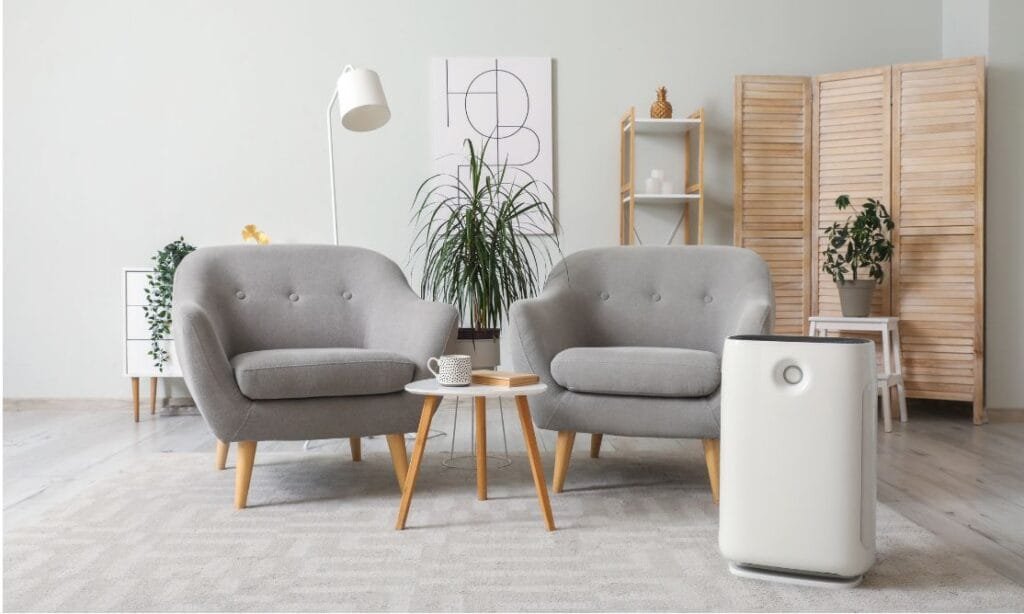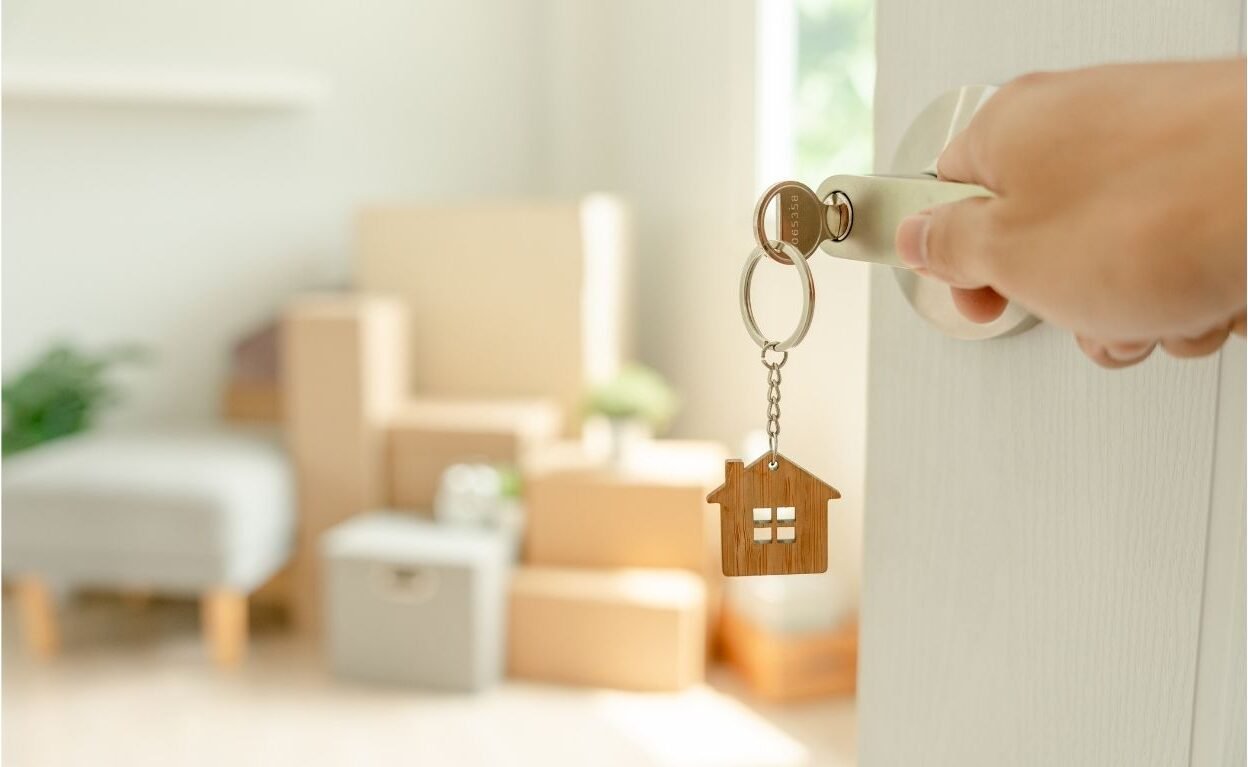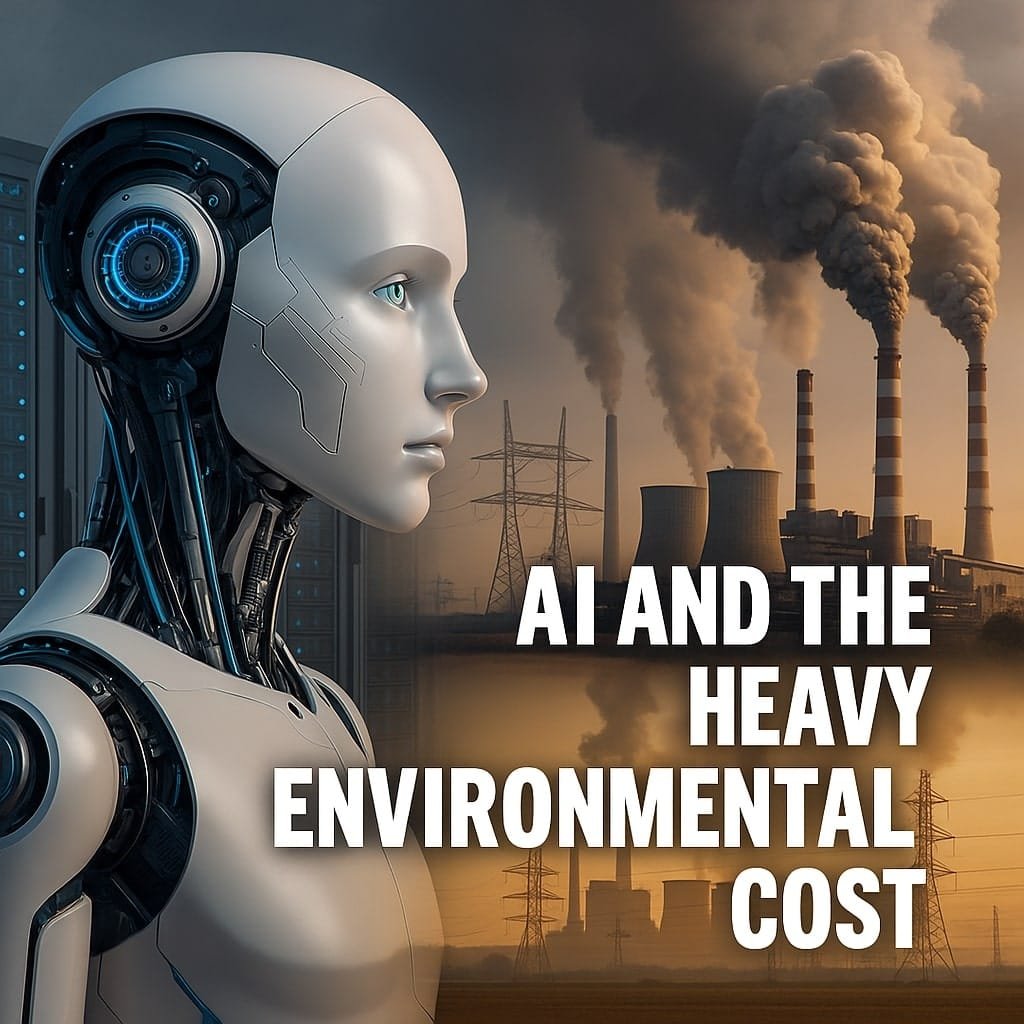Designing a healthy built environment must prioritize healthy indoor air quality. Construction materials, furniture, finishes, walls, paints, and flooring all affect indoor air quality directly.
The importance of maintaining clean, healthy indoor air cannot be overstated, as it significantly influences our daily comfort and long-term health outcomes.
(For a full selection of brands & products for indoor air care, we invite you to visit our shop page).
Poor indoor air quality and health issues:
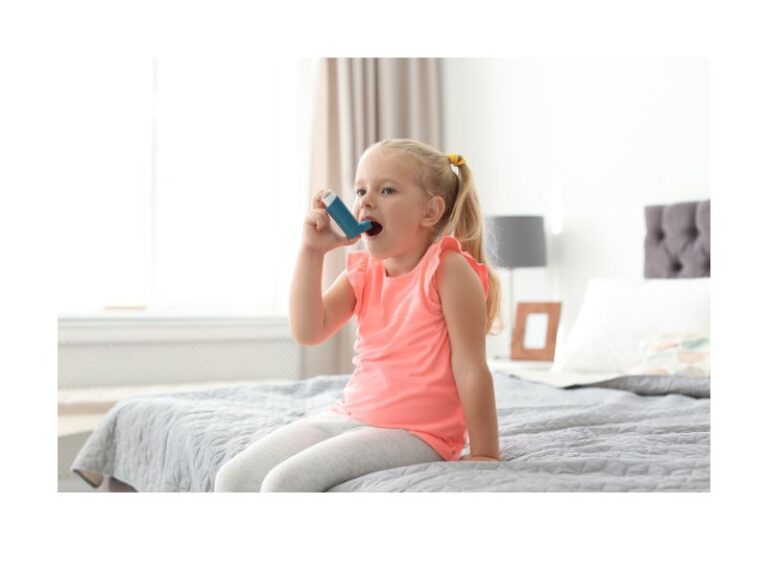
Our indoor air quality has a significant impact on our overall health and comfort. Poor indoor air quality (IAQ) could lead to a range of health issues, including:
Respiratory problems: Exposure to pollutants like dust, mold, and chemicals can irritate the respiratory system, leading to chronic coughing, wheezing, and shortness of breath.
Allergies: Poor IAQ can trigger or worsen allergies, causing symptoms like sneezing, a runny nose, itchy eyes, and skin rashes.
Headaches and fatigue: Inadequate ventilation and harmful chemicals can lead to persistent headaches and constant tiredness.
Asthma and lung diseases: Poor IAQ can worsen asthma symptoms, leading to more frequent attacks and chronic obstructive pulmonary disease (COPD).
Cognitive impairment: Poor air quality can impair concentration, memory, and cognitive function, affecting daily tasks and productivity.
Irritability and mood disorders: Indoor pollutants can increase stress, anxiety, and depression, causing mood swings.
Weakened immune system: Constant exposure to pollutants weakens the immune system and makes the body more vulnerable to infections.
Sick building syndrome: An individual experiences multiple symptoms from spending time in a building, often due to poor ventilation and exposure to indoor air pollutants, including headaches, nausea, and eye, nose, and throat irritation.
A variety of products are available to improve air purity and create a healthier indoor environment. These products can control, alter, or enhance IAQ by removing pollutants, regulating humidity, and introducing fresh air and more.
Air Filtration & Purification

The terms air purifier and air filter are often used interchangeably, but they refer to slightly different things. Here’s the distinction:
Air Purifiers
Function:
- An air purifier is a complete device designed to improve air quality by removing both particles (dust, pollen, dander) and pollutants (gases, odors, bacteria, viruses).
- Air purifiers often include a filter as part of the system, but they may also use other technologies like UV-C light, ionizers, or activated carbon to remove a broader range of contaminants.
- They target both airborne particles and gases, offering more comprehensive purification.
Examples:
HEPA air purifiers: Remove 99.97% of particles as small as 0.3 microns, including dust, pollen, pet dander, and mold spores.
UV air purifiers: Utilize ultraviolet light to kill bacteria and viruses in the air.
Ionic Air Purifiers: Release negative ions to attract and capture airborne particles. While they improve air quality by pulling in pollutants, their effectiveness can vary. Ionizers may alleviate respiratory conditions like allergies and asthma by reducing airborne allergens and pollutants.
Activated carbon filters: Absorb odors, chemicals, and gases from the air. Often combined with HEPA filters for maximum efficiency.
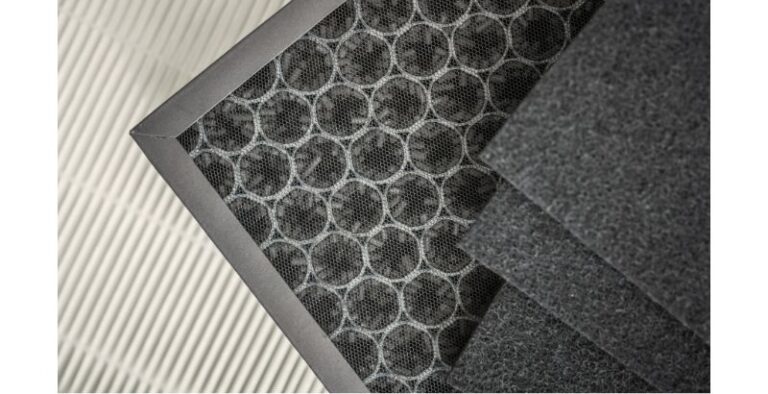
Air Filters
Function:
- An air filter is a component or device that captures particles like dust, pollen, pet dander, and other allergens from the air.
- It’s typically a part of HVAC systems, vacuums, or standalone units.
- Air filters do not remove gases, odors, or bacteria/viruses; they primarily focus on trapping airborne particles.
- Filters come in different types, like HEPA filters, carbon filters, and more.
Example include:
- HEPA (High-Efficiency Particulate Air) filters: These are the gold standard for capturing particles such as dust mites and pollen.
- Pleated filters: They provide basic filtration but are not as effective at capturing smaller particles.
- Electrostatic filters: Use static electricity to attract and capture particles.
To maintain their effectiveness, air filters should be cleaned and replaced regularly. Use air filters that don’t produce ozone since it can be harmful to your health. Choose an air purifier with HEPA filters that fits the size of the room. For odor removal, consider models with activated carbon filters.
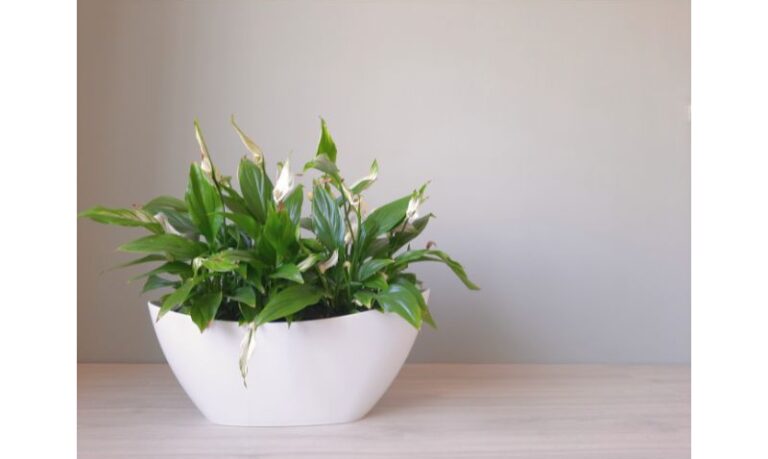
Air-Purifying Plants
Function:
Certain indoor plants can naturally improve air quality by absorbing pollutants and releasing oxygen. For example,
- Spider Plant: Absorbs formaldehyde, xylene, and toluene.
- Peace Lily: Removes ammonia, benzene, and formaldehyde.
- English Ivy: Effective at filtering benzene, formaldehyde, & mold spores.
- Snake Plant: removes formaldehyde and benzene, produces oxygen at night, and regulates humidity
- Spider Plant: Absorbs formaldehyde, xylene, and toluene.
Air Circulation & Control

Ventilation
Function:
Maintain proper air circulation by opening windows, using exhaust fans, or installing a mechanical ventilation system. Maintaining good indoor air quality requires proper ventilation systems to bring in fresh outdoor air and remove stale indoor air. This can include:
- Natural Ventilation: Opening windows and doors to let air circulate naturally.
- Natural Ventilation: Opening windows and doors to let air circulate naturally.
- Mechanical Ventilation: A system that actively moves air in and out of a building to maintain air quality and regulate temperature and humidity. It includes a range of components such as fans, ducts, filters, and heat recovery systems.
- Mechanical Ventilation: A system that actively moves air in and out of a building to maintain air quality and regulate temperature and humidity. It includes a range of components such as fans, ducts, filters, and heat recovery systems.
- Exhaust fans: A specific type of fan that removes air, typically from a single room or area, to the outside. They are commonly used to remove moisture, odors, and pollutants from bathrooms, kitchens, and laundry rooms.
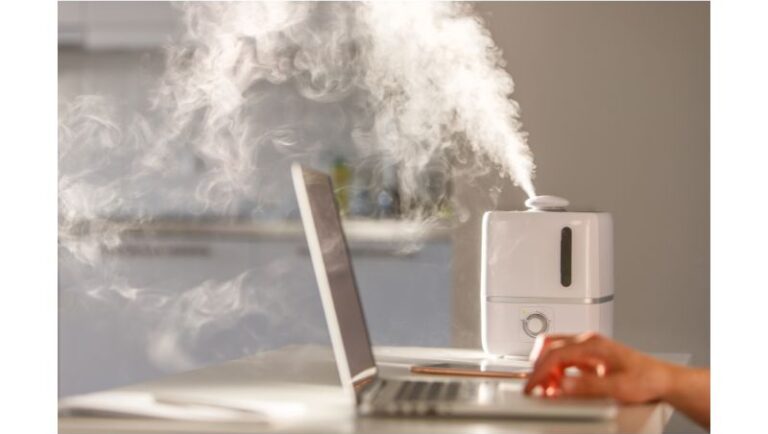
Humidity Control
Function:
- Humidifiers: Add moisture to the air, which can be helpful in dry climates or during winter to improve comfort, preventing dryness that can cause irritation in the skin, throat, and nasal passages.
- Dehumidifiers: Remove excess moisture from the air, which can help prevent mold growth and improve comfort in humid climates. Remove excess moisture from the air, preventing mold and mildew growth.
Air quality monitors
Function:
These devices measure indoor air quality, providing information about allergens, VOCs, carbon dioxide, and particulates.
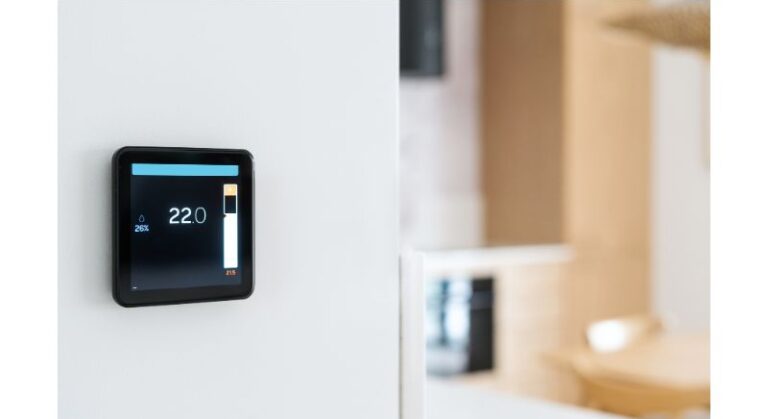
Smart home systems
Function:
Integrate with air purifiers and other devices to automate air quality control.
Professional Air Duct Cleaning
Performed every few years, it is important to have your air ducts professionally cleaned to remove built-up dust and allergens.
Material & Product Selection
Using VOC-absorbing Materials
Function: Improve indoor air quality by capturing and neutralizing volatile organic compounds (VOCs). These chemicals, emitted by various household products contribute to respiratory problems, headaches, and many other health issues.
One can notably reduce exposure to harmful pollutants by using VOC-absorbing materials in interiors. Examples of such materials include:
- Bamboo and cork products: These natural materials have inherent VOC-absorbing properties and can be used for flooring, furniture, and decor items.
- Bamboo Charcoal Bags: Natural air purifiers made from bamboo charcoal, known for absorbing VOCs, odors, and moisture. Example: Moso Natural Air Purifying Bags.
- Specialized wall coatings and paints: Designed to capture and neutralize VOCs. Examples, VOC-Absorbing Paint that reduces harmful emissions like AFM SafeCoat, Benjamin Moore Natura.
- VOC-Absorbing Paint: Specialized paints that contain additives to absorb VOCs released by other building materials, furniture, and cleaning products. Example: Sherwin-Williams SuperPaint with Air Purifying Technology.
- Absorbent Tiles: Wall or ceiling tiles that absorb VOCs, for example, CertainTeed AirRenew Gypsum Board.
- VOC-Absorbing Wall Panels: Wall panels infused with materials like zeolites or activated carbon that absorb VOCs and improve air quality in enclosed spaces. Example: CertainTeed AirRenew Drywall.
- Insulation with VOC-absorbing properties: Some insulation products can reduce indoor air pollution. For example, CertainTeed MemBrain vapor retarder.
- Indoor air purifiers with VOC-absorbing capabilities: Some models combine HEPA filtration with activated carbon for comprehensive air cleaning.
Use Low-VOC Materials
Aside from using VOC-absorbing materials, choose building materials and furniture with low VOC emissions from the start. This helps minimize indoor air pollution from off-gassing chemicals. Choose low-VOC or VOC-free products, such as paints, cleaning supplies, and furnishings, to reduce chemical off-gassing.

Air Fresheners
Function: Mask or provide a pleasant scent indoors without necessarily removing airborne pollutants.
There are, however, many air fresheners that contain VOCs and other chemicals that contribute to indoor air pollution and may irritate the respiratory system. Limit the use of synthetic air fresheners and use natural air fresheners like essential oil diffusers, homemade potpourri, baking soda or activated charcoal to absorb odors.
What to consider when selecting an air freshener?
- Ingredients List: Avoid air fresheners that contain volatile organic compounds (VOCs), such as formaldehyde, benzene, or phthalates, which can contribute to indoor air pollution and cause respiratory irritation.
- Fragrance Source: Choose products scented with essential oils, not synthetic chemicals. There are numerous undisclosed ingredients that may be harmful in synthetic fragrances.
- Certifications: The label should say “VOC-free” or “non-toxic,” which indicate safer ingredients.
- Aerosol Caution: Avoid aerosol air fresheners. Here’s why you should be cautious.
- Fine Particles: Particulate matter (PM) released by aerosols can easily be inhaled deep into the lungs. Individuals with asthma or other respiratory conditions may experience irritation from these particles.
- Chemical Propellants: Aerosols often use chemical propellants to disperse the product. VOCs such as butane, propane, etc. can pollute indoor air.
- Widespread Dispersion: Aerosolized particles remain suspended in the air longer and spread more widely throughout the room, increasing the risk of inhalation and prolonged exposure.
- Widespread Dispersion: Aerosolized particles remain suspended in the air longer and spread more widely throughout the room, increasing the risk of inhalation and prolonged exposure.
For these reasons, it’s safer to choose non-aerosol pump sprays as air fresheners, particularly those made with natural ingredients.
Air Cleaning Sprays
Function: Work actively to purify the air by eliminating or neutralizing airborne pollutants,
such as bacteria, viruses, mold spores, and allergens. They reduce airborne particles or odors temporarily, but their effectiveness is limited.
Be mindful of probable chemical irritants in some sprays as they often contain antimicrobial agents, enzymes, or other harmful substances.
A spray for air cleaning should be selected carefully to avoid toxicity or irritation. Here are some key things to look for:
- Ingredients List: Check for harsh chemicals like ammonia, chlorine, or synthetic fragrances, which can be an irritant or harmful if inhaled.
- Warnings and Labels: Look for explitcit warnings about potential skin, eye, or respiratory irritation on the label. Products labeled as “hazardous” or “use in well-ventilated areas” may contain stronger chemicals.
- Certifications: Buy products with certifications like “EPA Safer Choice” or “Green Seal,” indicating they are eco-friendly and safe.
- Natural Alternatives: Use natural ingredients instead of synthetic chemicals, such as essential oils.

DIY Spray
You can easily make your own DIY spray which is a simple, natural way to cleanse your space and enjoy aromatherapy.
Here’s how:
- Essential oils: Choose oils for your desired effect, like tea tree or lavender for antimicrobial properties.
- Mix: Fill a spray bottle with water, add 10-20 drops of essential oil, and optionally add a teaspoon of witch hazel or vodka for preservation.
- Shake well: Shake the bottle before each use to blend the oils and water.
- Spray: Use on surfaces or in the air to freshen and cleanse.
Essential oils that are known for their antimicrobial properties:
- Tea Tree Oil
- Properties: Antibacterial, antifungal, and antiviral.
- Uses: Commonly used in disinfectants, cleaning products, and skin treatments.
- Eucalyptus Oil
- Properties: Antibacterial and antiviral.
- Uses: Often used in air purifiers, respiratory treatments, and surface cleaners.
- Lavender Oil
- Properties: Antibacterial and antifungal.
- Uses: Used in natural disinfectants, air fresheners, and skincare products.
- Lemon Oil
- Properties: Antibacterial and antiviral.
- Uses: Frequently used in household cleaners, air fresheners, and hand sanitizers.
- Thyme Oil
- Properties: Strong antibacterial and antifungal.
- Uses: Found in disinfectants, natural preservatives, and respiratory treatments.
- Relaxing: Lavender, chamomile, frankincense
- Energizing: Peppermint, lemon, rosemary
Maintenance & Lifestyle
Lifestyle Habits
Smoking indoors, using strong cleaning chemicals, and not properly venting cooking appliances can all negatively impact indoor air quality.
Regular cleaning
Vacuuming, dusting, and changing air filters can significantly improve indoor air quality. Regular vacuuming with HEPA filters removes dust, allergens, and pet dander from carpets and upholstery.
Enhancing indoor air & environment
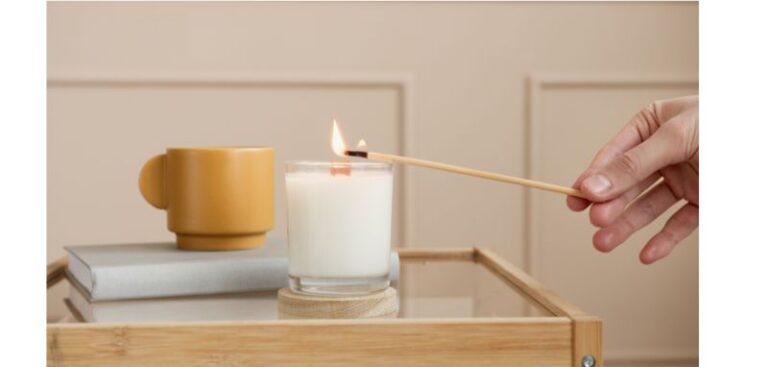
Scented Candles
Aromatic candles create a welcoming atmosphere indoors. However, not all candles benefit indoor air quality. Some, particularly those made with synthetic fragrances and paraffin wax (made from petroleum), release harmful chemicals like benzene and toluene when burned. This causes indoor air pollution and respiratory irritation.
Avoid paraffin wax and synthetic fragrance candles. There are better natural alternatives to candles, such as those made from soy or beeswax that are infused with essential oils.
Look for labels that say candles are made with natural ingredients, such as 100% essential oils, or are free of synthetic fragrances and harmful chemicals. Certifications like “Non-toxic,” “Phthalate-free,” or “Organic” can also guide you toward safer options.
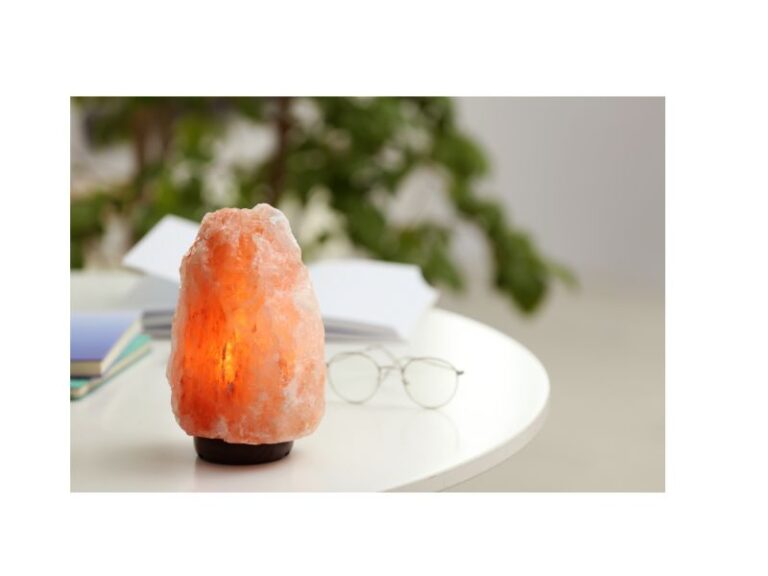
Himalayan Salt Lamps
Himalayan salt lamps are decorative lamps crafted from salt rocks mined in the Himalayan region of Pakistan. The warm amber glow of these lamps creates a serene and aesthetically pleasing atmosphere.
While scientific evidence is limited, many believe that Himalayan salt lamps purify the air by releasing negative ions. As a result, ions bind with airborne pollutants, allergens, and dust particles, causing them to settle out of the air and possibly improving respiratory conditions such as allergies and asthma.
To maintain, Himalayan salt lamps should be kept away from moisture, water sources, and direct sunlight, as exposure can deteriorate the salt. Also, buy salt lamps made from “genuine” Himalayan salt.

Essential oil diffusers
Disperse essential oils into the air, creating a fragrant atmosphere while contributing to improving indoor air quality. A natural alternative to chemical-based air fresheners, some essential oils even reduce airborne microbes with their antimicrobial, antifungal, and antiviral properties.
Types of Diffusers Examples:
- Ultrasonic diffusers: Create a fine mist by vibrating water and essential oil droplets at high frequencies.
Nebulizing diffusers: Use a pump to atomize essential oils into a cold air stream, resulting in a more concentrated and potent diffusion. - Heat diffusers: Warm essential oils to release their fragrance, but they can alter oil’s properties.
- Ultrasonic diffusers: Create a fine mist by vibrating water and essential oil droplets at high frequencies.
While ultrasonic and nebulizing diffusers are popular, there are additional ways to disperse essential oils:
- Evaporative diffusers: These use a fan to circulate air over a pad saturated with essential oil.
- Candle diffusers: Essential oils are added to melted wax, releasing fragrance as the candle burns.
- Personal diffusers: These include necklaces, bracelets, and other wearable items with compartments for essential oils.
Point Of Alignment
A healthy built environment starts with prioritizing clean indoor air quality. Maintaining healthy air is essential for both daily comfort and long-term well-being. When using methods to improve air quality, following these essential guidelines ensures the air remains safe and non-toxic.

